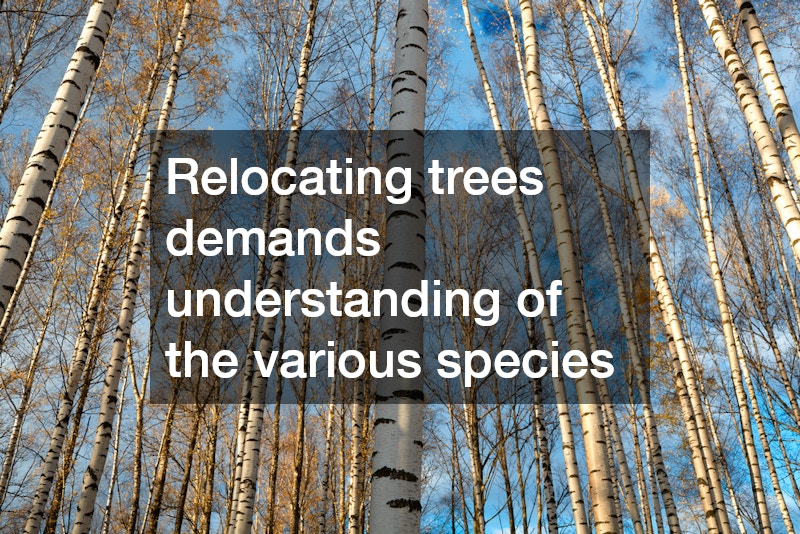This article explores the factors and criteria influencing a tree relocation service and its success, offering insights into commonly relocated species and best practices. Relocating trees requires careful planning and execution to ensure their survival and continued growth in a new environment. Understanding how different species respond to being moved and the specific challenges they face is crucial for achieving positive outcomes in tree relocation. Young trees are generally more adaptable to relocation due to their smaller size and less developed root systems. They can adjust more easily to new soil conditions and climates, making them ideal candidates for successful relocation. In contrast, mature trees present greater challenges because their extensive root systems and larger biomass require more sophisticated methods and resources to move them successfully. The greater resilience of younger trees to stress can help them recover earlier from a move. By contrast, moving mature trees involves higher costs and technical expertise, often requiring heavy machinery and careful planning. However, mature trees bring substantial aesthetic and ecological benefits to a new site almost immediately upon relocation, which can be a significant advantage. Certain tree species are frequently chosen for relocation due to their adaptability and resilience. Oaks, maples, and pines are among the most common tree types because of their hardy nature and ability to adapt to new environments. These species often have flexible growing conditions, allowing them to thrive despite changes in soil or climate. Deciduous trees, like maples and oaks, have the ability to enter a dormant state, which makes them suitable for relocation. This dormancy reduces stress from transplantation since the trees experience minimal growth and draw fewer nutrients during the move. Evergreen trees, such as pines, also exhibit a strong potential for relocation, often withstanding environmental changes effectively due to their robust root systems. The specific soil conditions of both the original and new location are critical to the transplantation success of trees. Soil composition, moisture levels, and nutrient availability all influence how well a tree can adjust to its new surroundings. Selecting a site with compatible soil characteristics minimizes transplant shock and promotes healthy root establishment. Environmental factors, such as sunlight exposure, temperature variations, and local weather patterns, also play significant roles in a tree’s adjustment period. Trees accustomed to specific environmental conditions might struggle in areas with vastly different climates, affecting growth and longevity negatively. Ensuring these factors align closely with the tree’s original habitat can lead to a more successful relocation process. Choosing the correct season and timing for tree relocation is pivotal in maximizing survival and growth. The optimal time for moving trees generally coincides with their dormancy period, when metabolic activities are slowed. This timing reduces stress and allows trees to allocate more resources towards establishing roots in a new location. For deciduous trees, relocation during late autumn or early spring is ideal, as it avoids extreme temperatures that could impair root and foliage development. Evergreen trees, on the other hand, can often be moved throughout the year with proper preparation, although early spring allows for ideal conditions with increased precipitation. Proper timing ensures trees are better positioned to acclimate to their new environment without unnecessary stress. Effective tree relocation requires meticulous preparation to minimize stress and damage during the move. Steps such as pruning and root inspection are crucial in prepping a tree for transplantation, as they reduce mechanical damage and facilitate root recovery. Proper hydration is also fundamental to maintain the tree’s cellular processes active despite the transition’s stress. Prior to relocation, a detailed site evaluation ensures that the tree’s new environment is conducive to its survival. Soil samples and environmental analysis help determine compatibility, while additional elements such as irrigation systems and protection from wind exposure are arranged. These preparatory measures contribute to a more seamless transition and foster growth in the new location. Post-relocation care is essential for the long-term success and vigor of transplanted trees. Regular watering schedules tailored to the species’ needs and local climate conditions help mitigate transplant shock and support healthy root establishment. Mulching around the base conserves moisture and regulates soil temperature, creating a stable microenvironment for recovery. Monitoring the tree’s health in the weeks and months following relocation is critical to identify early signs of stress or decline. Arborists can recommend targeted interventions, including fertilization and pest control measures, addressing any deficiencies swiftly. Additional supports, like staking, provide protection against wind and mechanical disturbance during this vulnerable period. Successfully relocating trees demands a thorough understanding of the various species involved and the environmental conditions they require. Critical factors such as timing, soil conditions, and pre-relocation care determine the likelihood of success in tree relocation endeavors. Thoughtful planning, combined with informed techniques and practices, fosters positive outcomes and promotes the flourishing of transplanted trees in their new environments.What Tree Species Are Most Suitable for Relocation?
Young Trees vs. Mature Trees
Most Common Tree Species for Relocation
What Factors Affect the Success of Tree Relocation?
Soil and Location Conditions
Season and Timing for Relocation
What Are the Best Practices for Tree Relocation?
Preparation Techniques
Aftercare and Maintenance
.

